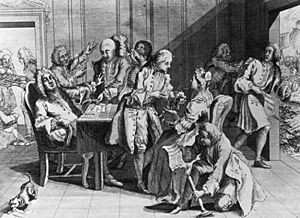Robert Jenkins (master mariner) facts for kids
Robert Jenkins was a Welsh sailor and ship captain from Llanelli. He became famous because of an incident involving his ear. This event helped start a war between Great Britain and Spain in 1739, known as the War of Jenkins' Ear.
Contents
What Happened to Robert Jenkins?
In April 1731, Robert Jenkins was sailing his ship, the Rebecca, back to Britain from the West Indies. His ship was stopped by a Spanish coast guard ship called La Isabela. The Spanish suspected Jenkins's ship of smuggling goods.
During this stop, the Spanish captain, Juan de León Fandiño, reportedly attacked Jenkins. Some stories say Fandiño tied Jenkins to a mast and cut off his left ear with a sword. He supposedly told Jenkins to tell his king that the same would happen to him if he was caught smuggling. Another account says a Spanish officer slit Jenkins's ear, and another tore it off. They then gave him the piece of his ear back.
How the Incident Led to War
When Jenkins arrived in Britain in June 1731, he told his story to King George II. He also gave a formal statement about what happened. This report was sent to government officials, who then complained to the Governor of Havana.
At first, the incident didn't get much attention. But years later, in 1738, the story became very important. British merchants who traded in the West Indies were having problems with Spanish ships. They used Jenkins's story to push for action against Spain.
Members of the British Parliament voted to ask the King to demand payment or justice from Spain. After many attempts to solve the problem peacefully, King George II agreed to start military actions against Spain. On October 23, 1739, Great Britain officially declared war on Spain. This war became known as the War of Jenkins' Ear.
Robert Jenkins's Life After the Incident
After the ear incident and the start of the war, Robert Jenkins continued his career at sea. He worked for the British East India Company, a powerful trading company.
In 1741, he was sent to an island called Saint Helena. He was there to investigate problems with the island's acting governor. Jenkins managed the island's affairs for about a year. He was also known for bravely protecting his ship and others from a pirate vessel.
What Happened to the Spanish Captain?
The Spanish captain, Juan de León Fandiño, who was involved in the ear incident, was later captured. In 1742, a British warship captured his ship, the San Juan Bautista. Fandiño was taken to England and held captive for 19 months. He was eventually released as part of a prisoner exchange agreement. He then returned to Spain.
Was the Story Really True?
For a long time, some people doubted if Jenkins's story was true. They thought it might have been made up to start a war. However, in the late 1800s, a historian named John Knox Laughton found old letters that confirmed Jenkins's account.
These letters were from Jamaica in 1731. A British admiral wrote about the "violence and villainies" of a Spanish commander named Fandino. The admiral mentioned that Fandino had used a captain "in a most barbarous inhuman manner, taking all his money, cutting off one of his ears." This evidence showed that Robert Jenkins's story was indeed true.
There was also a book published in 1739 called England's Triumph. It included an illustration of a Spanish ship cutting off Captain Jenkins's ear. However, the author of this book was named "Charles Jenkins," not Robert. Historians later found that this book didn't have much real information about Robert Jenkins himself.
See also
 In Spanish: Robert Jenkins para niños
In Spanish: Robert Jenkins para niños


